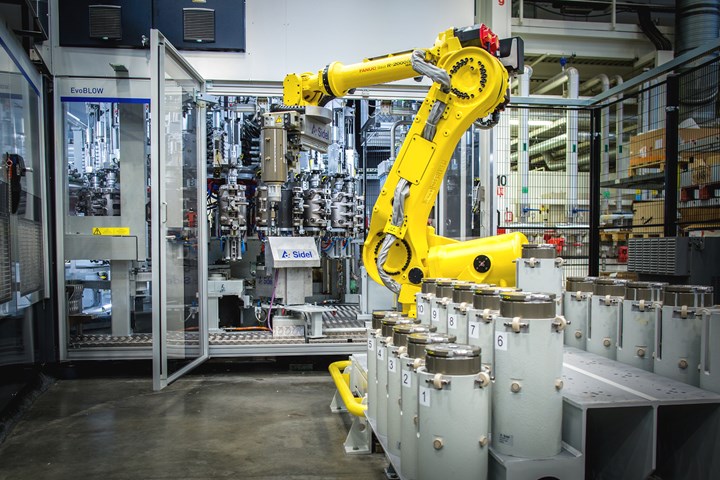Faster, More Automated Changeover for PET Bottles
Sidel has updated its Bottle Switch technology for its latest PET stretch-blow machines, adding robot assistance.
With Sidel’s updated Bottle Switch, mold changes are now fully robotized with a six-axis double-mold holder. (Photo: Sidel)
Bottle Switch is a quick format changeover system for PET bottles that was introduced by Sidel in 2010 and has now been updated with a higher degree of automation and adaptation to the company’s latest stretch-blow molders such as the EvoBlow series. Bottle Switch can be applied to gravimetric preform feeders, ovens and blowing wheels to support a quick switch of preform neck finishes and bottle shapes. Software allows users to select and apply the right equipment process and configuration for every container SKU.
The new changeover procedures minimize human intervention. As shown in a Sidel video, the new version of Bottle Switch employs a six-axis robot to change molds, which were replaced manually in the earlier semiautomated version of Bottle Switch. In addition, dedicated motors support the automatic, mechanical element positioning for the preform feeder’s infeed rails while also assisting horizontal adjustment of the oven’s heating modules and cooling shields. Digital clocks enable toolless manual positioning, instantly validating these new settings for the preform-feeder roller adjustments and vertical adjustments of the oven’s heating modules and cooling shields.
Overall changeover time with Bottle Switch reportedly can be reduced by 75% compared with a standard manual changeover, which could enable production of up to 13.2 million additional bottles/yr for an SBO 24 machine. When applied on the preform feeder and oven, Bottle Switch enables changeovers in just 17 min, vs. 65 min manually. Mold changes can be cut to just 30 sec from 2 min manually.
Related Content
-
How to Extrusion Blow Mold PHA/PLA Blends
You need to pay attention to the inherent characteristics of biopolymers PHA/PLA materials when setting process parameters to realize better and more consistent outcomes.
-
How Inline Vision Inspection Can Minimize Scrap in Molding
Once viewed by injection and blow molders as a necessary evil, machine vision technology today can continuously monitor and improve production while reducing costs.
-
Foam-Core Multilayer Blow Molding: How It’s Done
Learn here how to take advantage of new lightweighting and recycle utilization opportunities in consumer packaging, thanks to a collaboration of leaders in microcellular foaming and multilayer head design.














